What Strength Coaches & Researchers Say You Should Be Able to Squat: Including Official And Unofficial Strength Standards For Weightlifters, Athletes, And Ordinary Folks, Average Test Results, The Latest World Records, And More! (Plus Some Free Resources to Help You Squat More!)
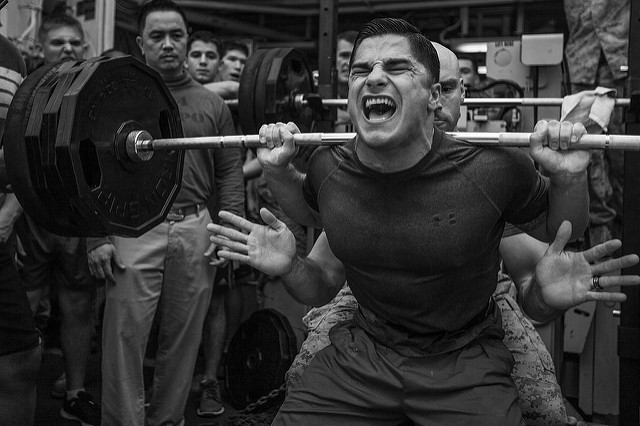
How much weight you can squat is one of the best indicators of your overall fitness and strength level. This article will show how you measure up to the various standards, and also help you set an ambitious goal for yourself.
This article will cover strength standards for the following squat exercises:
- bodyweight squats
- goblet squats
- barbell back squats
- barbell front squats
- barbell overhead squats
Squat Strength Standards
I know a lot of people who can squat big weights. That just comes with the territory in my line of work. Most of them are either powerlifters, fitness coaches, gym owners, or professional “gym rats.” But I’ve also got a friend who is constantly traveling for his high-stress job (where he puts in a lot of overtime), has a family, and who can squat over 400 pounds, which is well over double his body weight. And he’s not some genetic freak either. He worked up to this level slowly over the years. And if he can do it, you can, too.
Below, you’ll find a variety of strength standards for a handful of squat exercises. But before you dive in, it’s important to understand that strength training and weight lifting standards, in general, are difficult to establish because they are dependent on many different factors including:
- the specific variation of the exercise (e.g. back squats or front squats)
- experience level of the lifter
- age of the lifter
- gender of the lifter
- body weight of the lifter
- use of assistance gear (e.g. lifting suit, knee wraps, etc.)
- use of performance-enhancing drugs (e.g. steroids)
- technique variables such as barbell placement and stance width
For example, most lifters can back squat more weight than they can front squat due to the mechanics of the exercise. Similarly, most lifters can front squat more than they can overhead squat. Experienced lifters can obviously lift substantially more than inexperienced ones. And yet, the older you get, the more that your strength will naturally diminish due to aging. Men are stronger than women. And yet, women can surpass the average male’s performance with consistent training. Furthermore, there can be a great disparity between your maximum strength and your strength-endurance (e.g. 1-rep max vs 5-rep max). Also, the heavier that you are, the greater your maximum strength capacity will be, and yet, your pound for pound strength tends to be lower than lighter individuals.
As you can see, if you change just one variable, the strength standards change, too. So, needless to say, pinning down an exact standard to aspire to is really difficult. That’s why I like simple squat standards like the ones below.
Bodyweight Squat Standards
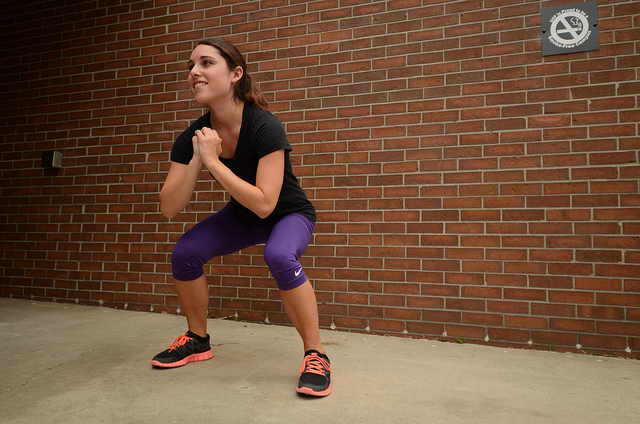
You should master the basic bodyweight squat before you move on to loaded squats like goblet squats and barbell back squats. Most fitness experts and strength coaches will agree that being able to perform at least 20-50 consecutive bodyweight squats with good form is a good basic standard to go by. For example, strength coach, Travis Stoetzel says that 30 full range of motion bodyweight squats is a basic standard, and that 100 reps is a better goal to work towards (source).
Since I like to keep things simple, here are my unofficial bodyweight squat standards:
Good – 20 reps
Better – 50 reps
Best – 100+ reps
There’s no need to get too dogmatic about it. Just make sure that you can do plenty of bodyweight squats with excellent technique.
Goblet Squat Standards
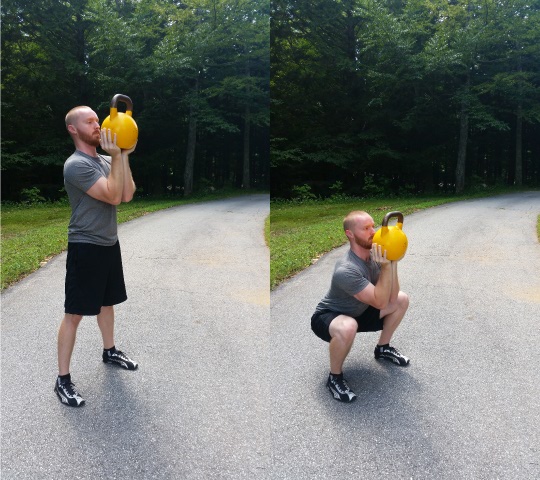
Once you’ve mastered the bodyweight squat, the Goblet squat is the next logical progression. Here are some recommended standards based on data I’ve compiled from strength coaches, Dan John, Andrew Read, and Pavel Tsatsouline, among others:
MEN:
Level 1: 3×10 with 16 kg (35 lbs)
Level 2: 3×10 with 24 kg (53 lbs)
Level 3: 3×10 with 32 kg (71 lbs)
Level 4: 1×20 with 32 kg (71 lbs)
Level 5: 5×5 with (2) 24 kg kettlebells (technically, this is a double kettlebell front squat)
WOMEN:
Level 1: 3×10 with 12 kg (26 lbs)
Level 2: 3×10 with 16 kg (35 lbs)
Level 3: 3×10 with 24 kg (53 lbs)
Level 4: 1×20 with 24 kg (53 lbs)
Level 5: 5×5 with (2) 16 kg kettlebells (technically, this is a double kettlebell front squat)
Note: I recommend achieving at least Level 3 prior to training with a barbell.
Barbell Back Squat – Standards
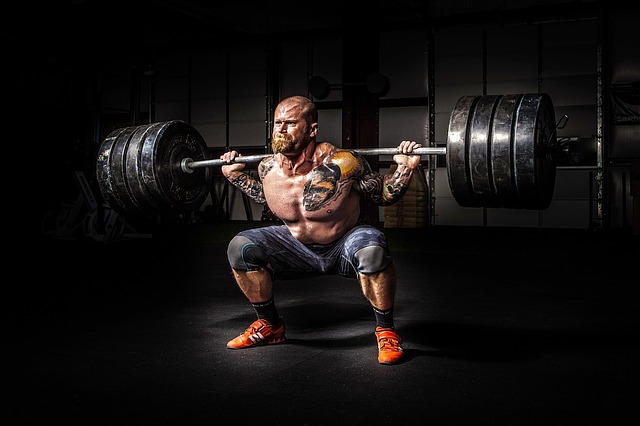
“There is simply no other exercise, and certainly no machine, that produces the level of…muscular stimulation and growth…than the correctly performed full squat.”– Mark Rippetoe, author of Starting Strength (a must-read for the serious strength athlete)
When most people think of the squat, they’re thinking about the barbell back squat, which is largely considered to be the king of all strength training exercises.
Every sub-culture within the strength and fitness communities have their own unique set of strength standards for the barbell back squat – powerlifters, olympic weightlifters, bodybuilders, crossfitters, the military, and even the streets – they all have their own charts and lists of both official and unofficial standards. There are also some geeks out there who have made a science out of calculating a lifter’s genetic potential – with or without drugs, with supportive gear or without, etc.
And then there are the in-the-trenches strength coaches who have amassed quite a bit of experience and have come to their own conclusions. Take Coach Dan John, for instance, who has coached athletes and weekend warriors alike for decades. He tells us in his book Intervention, that a barbell back squat with the equivalent of your body weight on the bar is expected. And being able to squat your bodyweight for 15 reps is a game-changer. So, there’s that, too.
And of course, there are a ton of different charts, formulas, and calculators that can help you determine your own personalized squat strength standards based on your size, weight, gender, and age, among other things (note: I’m partial to the tools at Symmetric Strength that a powerlifter friend of mine turned me onto awhile ago).
And if you want, you could spend a few hours doing research to get an approximate* figure to work with. And if you intend to compete at a high level in a strength sport, then that may be worth the effort. But for the rest of us who like to keep things simple, I’ve distilled all of my research on this topic into a couple of handy-dandy charts below.
The takehome lesson: it’s very hard and extremely unlikely that you’ll be able to get a 100% accurate standard for your squat performance. So, consider these standards as general guidelines, not absolutes.
John Sifferman’s Totally Unofficial Strength Standards
for the Barbell Back Squat Exercise
Note: the standards below apply to the barbell back squat exercise to powerlifting depth (i.e. descending below the point at which the thighs break parallel with the ground). To calculate the front squat and/or the overhead squat standards, see instructions below.
These standards are based on a percentage of your bodyweight, and most of the categories include a strength range. The lower end of the range will apply to larger/heavier weightlifters, and the higher end of the range will apply to smaller/lighter weightlifters. Keep in mind that these are general standards for your average adult male and female; and your age, experience level, and body weight, among other things, will largely determine your actual potential. For example, both teenagers and those in the Master’s divisions (e.g. seniors) will have slightly lower strength standards than those listed here.
Men:
Newbie = 65 lbs
Beginner = 75-80% of your body weight
Intermediate = Body weight + 10-20% of your body weight
Advanced = Body weight + 40-60% of your body weight
Expert = Body weight + 80-100% of your body weight
Master = 2.1-2.35 times your body weight
Wicked Sick = 2.4-2.65 times your body weight
Superhuman = 2.7-3 times your body weight
Olympian = 3-3.35 times your body weight
Squat Immortal = More than 3.35 times your body weight
Women:
Newbie = 45 lbs
Beginner = 55-65% of your body weight
Intermediate = 85-100% of your body weight
Advanced = Body weight + 15-35% of your body weight
Expert = Body weight + 40-65% of your body weight
Master = Body weight + 75-100% of your body weight
Wicked Sick = 2-2.25 times your body weight
Superhuman = 2.25-2.5 times your body weight
Olympian = 2.5-2.75 times your body weight
Squat Immortal = More than 2.75 times your body weight
Barbell Front Squat – Standards
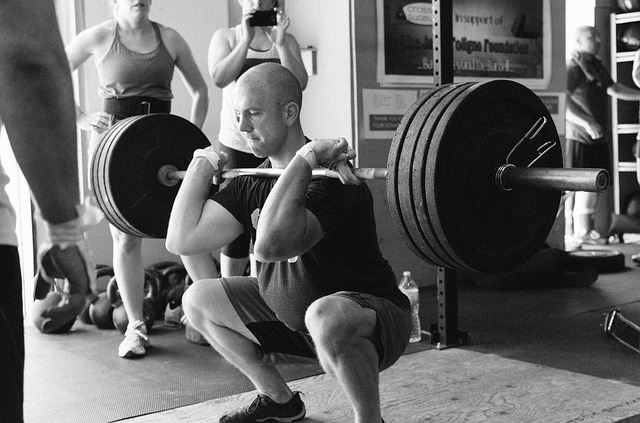
Your barbell front squat performance will generally be about 80-85% of your back squat performance. So, to determine your personalized standards for the barbell front squat exercise, multiply the numbers you came up with from the charts above by .8 or .85 (i.e. 80% or 85%).
For example…
- If you can back squat 100 lbs, you should be able to front squat about 80-85 lbs.
- If you can back squat 200 lbs, you should be able to front squat about 160-170 lbs.
- If you can back squat 300 lbs, you should be able to front squat about 240-255 lbs.
Barbell Overhead Squat – Standards

The overhead squat standards are really in a class of their own.
MEN:
Newbie: 0-50% of your body weight
Beginner: 50-75% of your body weight
Intermediate: 75-100% of your body weight
Advanced: 100-150% of your body weight
Elite: 150-175% of your body weight
Master: 175-200+% of your body weight
For example, if you’re a 150 lb male who can overhead squat 135 lbs, you’re at the intermediate level.
WOMEN:
Newbie: 0-35% of your body weight
Beginner: 35-50% of your body weight
Intermediate: 50-75% of your body weight
Advanced: 75-100% of your body weight
Elite: 100-125% of your body weight
Master: 125-150%+ of your body weight
For example, if you’re a 120 lb female who can overhead squat 125 lbs, you’re at the elite level.
Barbell Back Squat World Records (with Lifting Gear)
The world records for barbell back squats with gear are:
MEN: On October 8, 2011, Jonas Rantanen of Finland performed a squat with a weight of 575 kg (1268 lbs) at the Bullfarm Powerlifting Championships in Helsinki. (Source)
WOMEN: On October 29, 2005, Becca Swanson of the USA performed a squat with a weight of 387.5 kb (854.3 lbs) at the World Powerlifting Organization in Chicago, Illinois. (Source)
Barbell Back Squat World Records (RAW)
The world records for raw barbell back squats without lifting gear are:
MEN: 942 pounds by Daniel Bell of the USA on April 17th, 2016. (Source)
WOMEN: 615 pounds by April Mathis of the USA on October 29th, 2011. (Source)
John’s Recommendations
So…how much should I be able to squat, John?
Well, I think that most people who are not strength athletes (e.g. powerlifters), should strive for reaching or exceeding the Advanced Category in the standards above. For men, that is a barbell back squat with roughly 150% of your body weight on the bar. For women, it’s roughly 125% of your body weight on the bar. I think that’s an ambitious, yet doable goal for most people.
You want numbers? I’ll give you numbers!
If you want to take it to the next level, and you’d like some nice round numbers to aim for, here you go:
100-150 lb Males: 300 lb squat
150-200 lb Males: 400 lb squat
200+ lb Males: 500 lb squat
90-125 lb Females: 150 lb squat
125-175 lb Females: 200 lb squat
175+ lb Females: 300 lb squat
Closing Thoughts: How Much Weight Should YOU Squat?
So, having seen the standards, are you going to settle for a beginner or intermediate level performance, which is where most people hover their entire lives? At least, those who are brave enough to touch a barbell in the first place. Or, are you going to work towards the impressive advanced levels and beyond? All it takes is some commitment, hard work, and consistency. And by the way, I think that anyone who can meet the advanced squat standards outlined above – with proper technique and full range of motion – is light-years beyond your average fitness trainee.
And just between you and me, most people don’t need to be any stronger than that to function at a high level in life, work, and sport. Of course, you could double down for the long haul and work towards a double or even triple body weight squat, and there are pros and cons to that decision. The good news is that it’s completely up to you. It’s all about how bad you want it.
And in all seriousness, whether your goal is to explore your genetic potential and break world records or to just to master the simple body weight squat – if YOU think you can do it, then I think you can, too.
So, get after it.
Now, not that you care, but there was this one time that I decided to see how many bodyweight squats I could do in a row. It was hard, crazy, and hilarious. I couldn’t walk normally the next day, and I was sore for a week. And I got the whole thing on camera. I hit 100 reps a few minutes in.
So, how much ya bench squat, bro?
Related Posts
- How Much Should I Be Able To Deadlift? (Deadlift Standards)
- How Many Pushups Should I Be Able To Do?
- How Many Pull-ups Should I Be Able To Do?
- How Long Should I Hold The Plank Exercise For?
- How to Squat Properly: How to do Bodyweight Squats with Excellent Technique
- How to Achieve Greater Squat Depth
- How to do Bodyweight Jump Squats
- Single Leg Squat Beginner Exercises (Pistol Squat Progression)
- 25 Tips on How to Lift Heavy Weights Safely
If you found this article helpful, please share it with your friends:
.jpg)
![]()
Health-First Fitness Coach
P.S. If you liked this post, then please signup for the newsletter, or follow me on Facebook or Twitter for daily updates and other interesting info.
References
- Augustsson, S., & Svantesson, U. (2013). Reliability of the 1 RM bench press and squat in young women. European Journal of Physiotherapy, 15(3), 118-126. [Citation]
- Comfort, P., & McMahon, J. J. (2014). Reliability of Maximal Back Squat and Power Clean Performances in Inexperienced Athletes. Journal of Strength & Conditioning Association.[PubMed]
- John, D. (2013). Intervention: Course Corrections for the Athlete and Trainer. California: On Target Publications.
- Rippetoe, M. (2011). Starting Strength: Basic Barbell Training, 3rd edition. Texas: The Aasgaard Company.
- Ritti-Dias, R. M., Avelar, A., Salvador, E. P., & Cyrino, E. S. (2011). Influence of previous experience on resistance training on reliability of one-repetition maximum test. The Journal of Strength & Conditioning Research, 25(5), 1418-1422.[PubMed]
- Seo, D. I., Kim, E., Fahs, C. A., Rossow, L., Young, K., Ferguson, S. L., & So, W. Y. (2012). Reliability of the one-repetition maximum test based on muscle group and gender. Journal of sports science & medicine, 11(2), 221.[PubMed]
- Soares-Caldeira, L. F., Ritti-Dias, R. M., Okuno, N. M., Cyrino, E. S., Gurjão, A. L., & Ploutz-Snyder, L. L. (2009). Familiarization indexes in sessions of 1-RM tests in adult women. Journal of Strength & Conditioning Research, 23(7), 2039-2045.[PubMed]
- http://www.exrx.net/Kinesiology/Squats.html
- http://www.exrx.net/Testing/WeightLifting/SquatStandards.html
- http://powerliftingwatch.com/
- http://www.rawfitnesscombine.com/benchmark/overhead-squat-1-rep-max-by-bodyweight/http://www.readpt.com/2016/03/building-the-squat/
- http://www.strengthandconditioningresearch.com/exercises/squat/#2
- http://startingstrength.com/files/standards.pdf
- http://strengthlevel.com/
- http://strengthstandards.co/
- http://strengthstandards.com/
- http://strongfirst.com/
- http://symmetricstrength.com/
*Scientists whom have done studies on One-Rep Max testing have found that there are significant individual variances in the accuracy of the results from 1RM testing, with great variances for untrained individuals (Source).
So what are your numbers, John? Age, weight, 1RM, 5RM, 15RM, back squat, front squat, overhead squat, etc?
I couldn’t tell you since I haven’t tested any of them in years. And when I did, I never performed any near-max effort squats since back squats always gave me back trouble. I can tell you that my best barbell clean is 225 lbs at 165 lb body weight. And my best snatch is 185 lbs. If you count those as a front squat and overhead squat, it looks like that would have put me in the “advanced” category listed above.
So I turn 70 in October…I think this needs to be age-adjusted…how much should a 70 yrar-old guy be able to squat?
It really depends on a lot of factors, Steve (as mentioned in the article). And so, I might recommend looking into that strength calculator on Symmetric Strength (or similar). But generally speaking, your standards will probably be around 30-40% lower than the ones I posted.
I like this post, it is good to see how I compare up to the squat standards haha! Even though my legs are killing from my leg day yesterday, I agree squats are one of the best exercises you can do!
do you think it will be possible for me to squat 150KG by the end of next year, may 2016 my 1RM squat was 105 it’s now 135KG at 61KG BW I started working out last year march 2015 and got into power lifting the beginning of this year.
Yes. I started at the bar on the SL lift in March. I am not up to 120kg 5/5/5/5/10 My max 1RM is 165kg. I am only 75kg.
I didn’t do squats until I started SL but will admit ive been running a long time and ride bike on cross-country trips of up to 3000-6000KM sometimes so I had some strength in there already.
41 yrs old, male, BW=235 lbs, high bar barbell squat below parallel 1 rep max= 475lbs & deadlift=495 lbs
Great and informative article.
But to say at 165 lbs. I should shoot for a 400 pound squat is ridiculous in my opinion. My outdoor fitness station simply doesn’t have the capacity for this kind of weight outside a gym with professional equipment. Besides, it’s just not necessary to maintain a high degree of fitness. Also such heavy weights dramatically increases the risk of injury and overloads the joints.
I’m a semi-pro mountain biker and I can maintain excellent lower body physical condition with 100 lb. squats.
May not impress the gym rats or the obsessive compulsive YouTube steroid boys, but that’s not what I’m in it for. Any squats are better than no squats.
Hey 007. These are standards purely for strength. As a semi-pro mountain biker these are not the right metrics for you. It’s like a powerlifter fretting over his Strava segments. Sport specific endurance and strength-endurance focused programs are what you should be using resistance training for, and you should look for metrics that relate to performance in your sport (which will be discipline dependent). You’ll inevitably see improvement in your 1RM as well but this should not be your focus and will be relatively modest. I’ve worked with several pro cyclists and none would exceed the advanced category on 1RM, and we’re talking roadies who have to get trousers tailored to fit their thighs!
Are these 1RM numbers here in your charts? You don’t seem to say.
I had same question.
Said some similar things recently on a Blog site! I got slated by the Big weigh ers out there who are naturally heavy and big built! They were saying BW has know part what so ever to play in lifting’ well they would wouldn’t they! Lol
I squat 310 now I weigh 160 and am 16. Do you think it’s possible to hit 380 in a year?
Your squat video was nice and long and inspired me to knock out a few. Did you ever take the time to count how many squats you ended up doing?
So what about someone who be is 320 lbs. Expecting normal being 600+ is insane. That can’t be right. Not only that we are lifting a few hundred just naturally.
Coach, You gave us numbers for Deadlift;
150-200 lb Males: 315 lb deadlift
But For same male Squat; 400 lb…
Why???
I didn’t search the comments to see if anyone else has mentioned this but I believe the new raw squat record was set by Ray Williams in 2019 at 1080lbs during the Arnold Sports Festival.